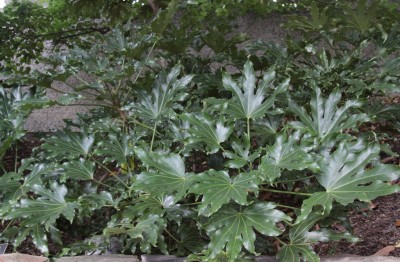






Japanese aralia is a tropical plant that makes a bold statement in the garden, in outdoor containers or as a houseplant. Find out about fatsia growing conditions and care requirements in this article.
The common names Japanese aralia plant and Japanese fatsia refer to the same broadleaf evergreen, known botanically as Aralia japonica or Fatsia japonica. The plant features huge, deeply lobed leaves that grow to about a foot in width atop long leaf stems that reach up and outward. The plant often leans to one side because of the weight of the leaves, and it can reach a height of 8 to 10 feet. Older plants may grow to a height of 15 feet.
The bloom time depends on the climate. In the U.S., fatsia usually blooms in fall. Some people think the flowers and the shiny black berries that follow them aren’t much to look at, but the terminal clusters of bright white flowers offer relief from shades of green in deep shade where aralia likes to grow. Birds love the berries and visit the garden often until they are gone.
Despite the name, fatsia is not native to Japan. It is grown around the world as a cultivated plant, and it originally came to the U.S. from Europe. There are some lovely cultivars, but they are hard to find. Here are some varieties that are available online:
Japanese aralia care is easy if you give the plant a good location. It likes medium to full shade and slightly acidic, compost-rich soil. It also grows well in large containers placed on shady patios or under trees. Excessive sunlight and strong winds damage the leaves. It is a tropical plant that needs the warm temperatures found in U.S. Department of Agriculture plant hardiness zones 8 through 11.
Water the plant often enough to keep the soil moist at all times. Check plants growing in containers often as they can dry out quickly. Fertilize plants growing in the ground in spring after the danger of frost has passed. Use a tree and shrub fertilizer with an analysis of 12-6-6 or similar every year. Fertilize potted plants with a fertilizer designed for plants growing in containers. Follow the package instructions, withholding fertilizer in fall and winter.
Fatsia needs annual pruning to maintain a bushy growth habit and healthy, glossy leaves. Renewal pruning is best. You can cut the entire plant to the ground in late winter just before new growth begins, or you can remove one-third of the oldest stems each year for three years. In addition, remove leaf stems that reach too far beyond the plant to improve the appearance.
Copyright © www.100flowers.win Botanic Garden All Rights Reserved